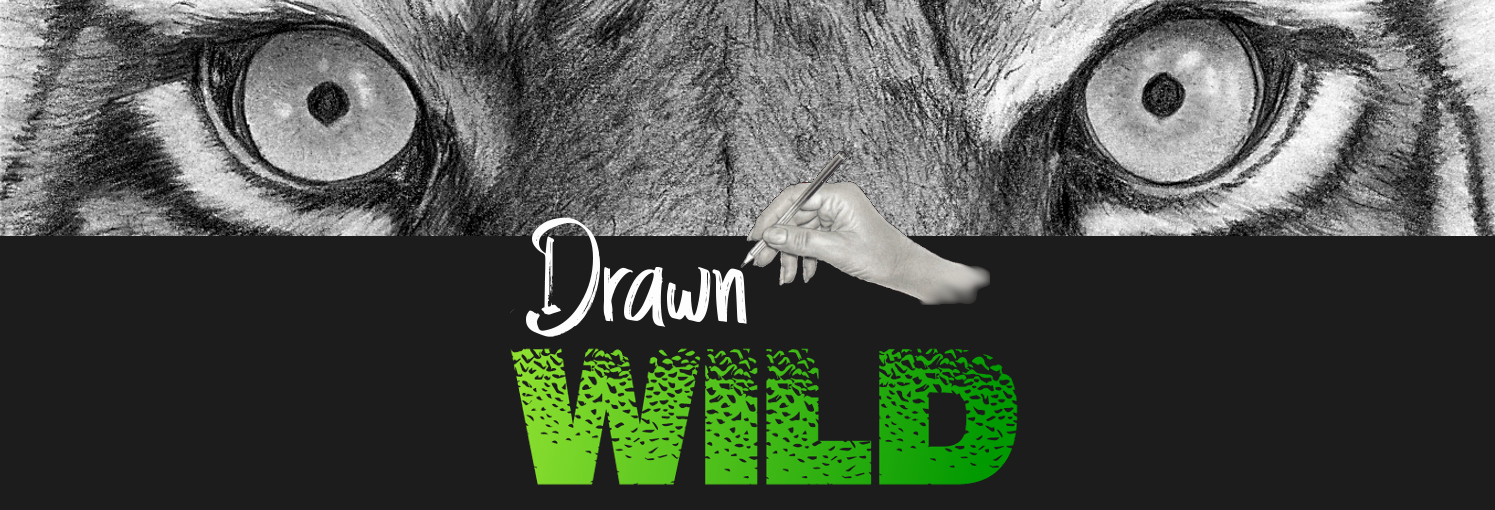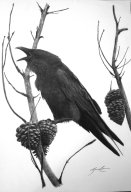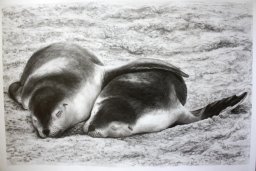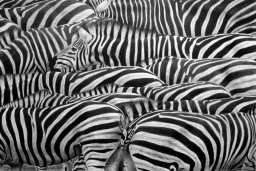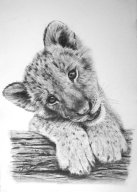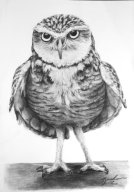

There are three subspecies of gorillas living in different parts of Africa with only very slight differences between them. These are the Western Lowland Gorilla (gorilla gorilla), the Eastern Lowland Gorilla (gorilla graueri) and the Mountain Gorilla (gorilla berengei). Of these, the mountain gorilla is the most endangered.
Did you know: When a gorilla drinks (which is rarely) it soaks the back of its hand and sucks the water from the fur!

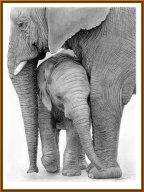
Pride and Joy. This painting won "People's Choice Award" in the 2007, Campbeltown Council Art Show gaining me my first award for my art work so it has real significance for me.
Did you know: Studies have shown that elephants help protect forest health in central Africa by distributing the seeds of trees. Because they roam over such great distances, elephants play a key role in spreading tree seedlings far and wide. Scientists have documented lower tree diversity in forests that have lost elephants, meaning a less healthy and resilient forest.
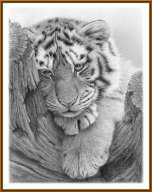
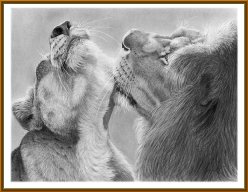
A gentle and touching moment in the life of one of the world's fiercest creatures.
Lions once lived in southern Europe, Africa, and parts of Asia. Today, however, they are confined mainly to the game reserves of Africa, with a few still living in the Gir Forest of India.
Did you know: A lion's tail is different from that of the other members of the cat family, it has a tassel end. The tail can be used for signalling in a wide-range of situations; for instance, mother to cub, 'come this way', one huntress to another, 'I'm going around the other side', or even from lioness to lion, 'come here Big Boy' or alternately 'Don't even think about it!!'.
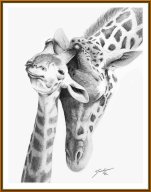
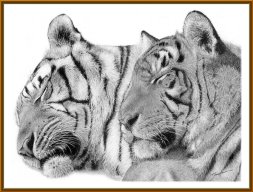
Unlike lions, which are social animals and live in prides (families), tigers are solitary animals that only rarely meet, except to mate. The best places in the world to see wild tigers in their natural habitat are Ranthambhore, Bandhavgarh and Kanha national parks in India and they have a thriving eco-tourism business as a result.
Did you know: If you shave the hair off of a tiger, it will look exactly like a shaved lion; the stripes are only on its fur, not on its skin.

Both young and adult otters are inquisitive and love to play. They throw, bounce and roll rocks or sticks, play tag and hide-and-seek, chase their tails, dunk each other, wrestle, and slide on mud or snow just for fun.
Did you know: As with humans, old otters have white whiskers.
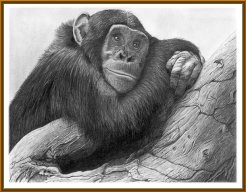
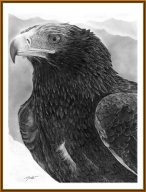
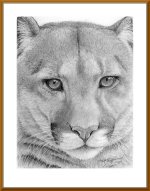
Did you know: The cougar holds the Guinness record for the animal with the greatest number of names, with over 40 in English alone. "Puma" is the common name used in Latin America and most parts of Europe.
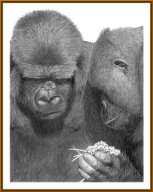
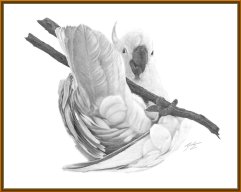
Sulphur-crested Cockatoos are common and familiar all over Australia and are probably one of our best known parrots. They are extremely intelligent, loud, mischievous, fun and can live on average between 70 and 90 years! In captivity they are great talkers.
Did you know: They can hold major grudges if they are ever badly treated but will be more affectionate than a dog if treated well.
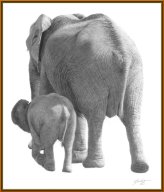
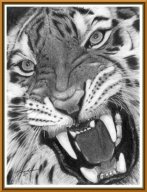
In a poll conducted by Animal Planet, the Tiger was voted the world's favourite animal, narrowly beating man's best friend, the dog. More than 50,000 viewers from 73 countries voted in the poll. The tiger received 21 percent of the vote, the dog 20, the dolphin 13, the horse 10, the lion 9, the snake 8, followed by the elephant, the chimpanzee, the orangutan and the whale.
Did you know: The oldest remains of a tiger-like cat, called Panthera palaeosinensis, have been found in China and Java. This species lived about 2 million years ago, at the beginning of the Pleistocene, and was smaller than a modern tiger.

Visually, the male is highly distinctive and is easily recognized by its mane. The head of the male lion is one of the most widely recognized animal symbols in human culture. It has been depicted extensively in literature, in sculptures, in paintings, on national flags, and in contemporary films and literature.
Did you know: As with other cats, the male lion's penis has spines which point backwards. Upon withdrawal of the penis, the spines rake the walls of the female's vagina, which may cause ovulation. Ouch!

The harvest of elephants, both legal and illegal, has had some unexpected consequences on elephant anatomy as well. African ivory hunters, by killing only tusked elephants, have given a much larger chance of mating to elephants with small tusks or no tusks at all. The propagation of the absent-tusk gene has resulted in the birth of large numbers of tuskless elephants, now approaching 30% in some populations (compare with a rate of about 1% in 1930). Tusklessness, once a very rare genetic abnormality, has become a widespread hereditary trait.
Did you know: According to biologists, the elephant's trunk may have over forty thousand individual muscles in it, making it sensitive enough to pick up a single blade of grass, yet strong enough to rip the branches off a tree.
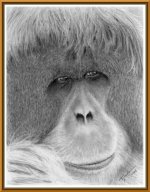
Did you know: Orangutans are among the most intelligent primates. They use a variety of sophisticated tools and construct elaborate sleeping nests each night from branches and foliage. Their name means "Man of the Forest" in Malay.
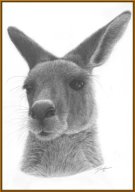
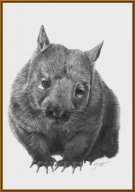

The Tasmanian Devil is world's largest surviving carnivorous marsupial.Early European settlers called it The Devil due to its spine chilling screeches and screams, reputed bad temper and its black colour.
Did you know: Mothers give birth after about three weeks of pregnancy to 20 or 30 very tiny young.These tiny babies crawl up the mother's fur and into her pouch. However, the mother has only four nipples, so only a handful of babies ever survive.

These beautiful animals are amongst many "big cat" species that are endangered or critically endangered in the wild, mainly due to loss of habitat through human land development and hunting. What a sad loss it would be if they disappeared forever in the wild.
Did you know: Siberian tigers are capable of dragging prey that would take more than a dozen men to move! The Amur leopard has been known to leap more than 19 feet horizontally and more than 9 feet vertically! The snow leopard does not roar, rather it meows and purrs. Particularly in heraldry, the snow leopard is known as "the Ounce".
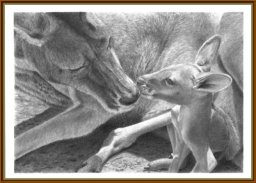
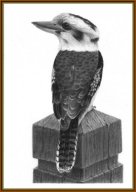
The kookaburra is the world's largest kingfisher. It measures up to 46 cm from the tip of its beak to the tip of its tail. Kookaburras are best known for their unmistakable call, which is uncannily like loud, echoing human laughter, They are carnivorous and will eat lizards, snakes, insects, mice and raw meat.
Did you know: The laughing kookaburra's early dawn and dusk cackling chorus earned it the nickname “bushman’s clock.”

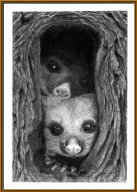
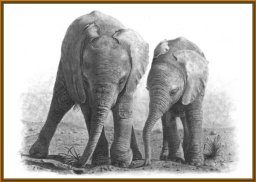
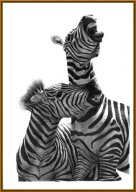
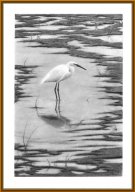

Rhinoceros are built like a tank but usually gentle as a lamb. There are five species of rhinoceros still alive today. These include the white rhinoceros, the black rhinoceros, the Indian rhinoceros, the Sumatran rhinoceros and the Javan rhinoceros.
Did you know: A rhinoceros can survive four to five days without water and.....A group of rhinos is referred to as a crash!
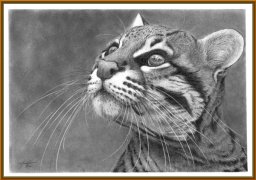

Wolves are of the family of animals that includes dogs, foxes, coyotes dingoes, African hunting dogs, many types of foxes, and several kinds of jackals. They are native to America, Canada, Asia, Europe and the Arctic.
Did You Know: Wolves walk and run on their toes, which helps them to stop and turn quickly. This also prevents their paw pads from wearing down.
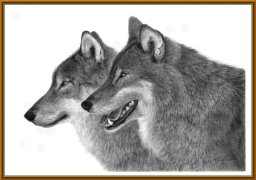

When the World Wildlife Fund (WWF) needed a symbol, they turned towards Chi Chi, the only giant panda in the Western world at that time, as a symbol for all endangered animals. She was a rare animal, like her wild panda cousins in China, and her form and color were the ideal basis for an attractive symbol.
Did you know: The sounds made by the Panda are referred to as bleats, honks and growls. The giant panda, which the Chinese call "large bear-cat", spend up to 16 hours a day eating


Lions' claws are retractable. This helps keep the claws sharp, and prevents injury during play, etc. The dewclaw on the front limbs is often used as a toothpick. Lion's will often scratch trees to keep their claws sharp and to mark out their territory.
Did you know: Faded leopard type spots can be found on young lions and some females, which indicate that the lion once lived in a more forested habitat. Cubs lose the spots that they have when they reach adulthood!
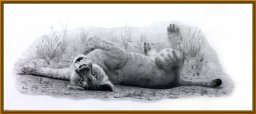

Despite their huge size, gorillas are peaceful, family-oriented, plant-eating animals. The average lifespan of a gorilla in the wild is about 35 years, but in captivity they may live as long as 50 - 55 years.
Did you know: Mountain gorillas cannot swim but they can use tools to solve problems. For example, they have been seen using a tree branch as a bridge to cross a patch of muddy ground!
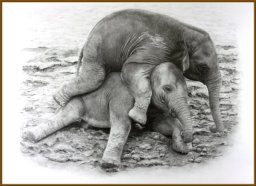


Ever wonder why zebras have never been used by humans in the way that horses and donkeys have? According to writer Francis Galton, the Dutch Boers, among others, tried and failed to tame zebras to be used in transportation. The animals frequently escaped their enclosures, ignoring their training. This ‘untrainable’ behaviour may be the result of evolution: since zebras naturally live in large groups in an environment full of predators, their strong survival instinct makes them considerably less friendly to humans than their horse and donkey cousins.
Did you know: A group of zebra's is called a "Dazzle"

There are 6 out of 9 recent subspecies of tigers left on Earth. How long they will be able to survive though is in question. Right now all 6 of these remaining species are considered to be endangered.
Did you know: One of the problems with tiger decreasing population is that less than half of their offspring live to be 2 yeas of age, let alone mature enough to mate themselves. Those that do survive though are usually about to live about 15 years in the wild. In captivity they can live about 20 years on average. Some of the Siberian Tigers in captivity though are more than 25 years old so they seem to do better than the other species!
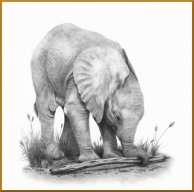
Graphite Painting of Elephant baby.
Elephants are the biggest land mammals still alive. They have been divided in two families: The Elephas and the Loxodonta.
Actually there are only three species of elephants still present: The African bush Elephant, The African Asian Elephant and the Asian Elephant (Indian Elephant). The mammoths where part of this family but have completely disappeared by the 2000 B-C.
Did you know: They are the symbol of wisdom in the Asian culture and they are renowned for their great memory and intelligence.

Elephants live in a society with a structured social order. Females and males live very different lives. Females live their entire life in families made up by the elderly mothers, daughters and sisters. The matriarch is usually the oldest female elephant of the tribe will lead the group. The males on the other hand spend their lives alone and will return to the group for mating.
Did you know: The fights between males can look very dangerous and violent but it is extremely rare that one of the combatants will suffer grave wounds. When an elephant dominates the fight the other one will back off and surrender, avoiding any wounds. This can be seen all year around, but during the breeding season, the fights get even more dangerous and often major wounds can result.


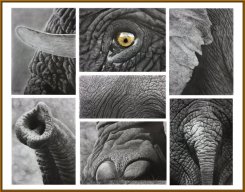
This was a finalist in the 2011 Waterhouse Natural History Art Prize and was judged "Highly Commended". The studies are arranged to be perceived as the whole animal.
Did you know: One of the softest parts of an elephants body is at the back of the ears, which is called the knuckle. Elephant trainers, called Mahouts, use their feet to steer or give commands to the animal via the knuckle at the back of the ears.
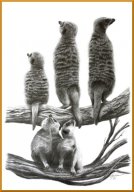
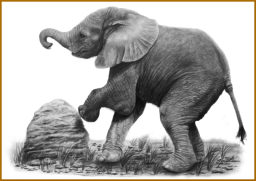
With the exception of weakened or young elephants becoming prey to lions and other strong predators in the wild, they are known to have no natural enemies. In other words, most other animals respect elephants
Did you know: Elephants are afraid of bees! They show their discomfort around bees by flapping their ears, kicking up dust, making noises, or running away when they hear the buzzing of a hive nearby. The fear is so strong that African farmers have started to keep beehives near their crops to keep elephants out.
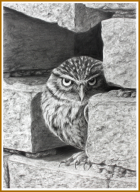
There are over 225 species of owl in the world, 11 native to Australia. The largest owl in Australia is the Powerful Owl living on the East coast and it's main food source is possums! There are 13 species listed as endangered and 6 critically endangered.
Did you known that the eyes of an owl are not true “eyeballs? Their tube-shaped eyes are completely immobile, providing binocular vision which fully focuses on their prey and boosts depth perception.
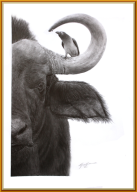
They clear off ticks, mites, and other parasites, and their calls can serve as warnings when predators are nearby. However, recent research suggests that oxpeckers can also be bad for their hosts: Why? They can create or worsen injuries in order to feed on the blood from them.
Did you know: Some oxpeckers act as warning systems for their hosts. When a predator is nearby, they’ll make high screeching sounds that warn of the oncoming danger. This can be life-saving for animals like the rhinoceros that have terrible eyesight.
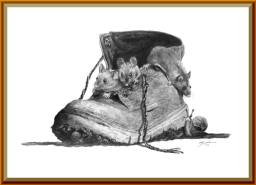
A female house mouse can give birth when they are only two months old, and they are able to have to up to a dozen babies every three weeks. This means she could have as many as 150 offspring in a single year!
Did you know: Despite their tiny bodies (and even smaller stomachs!), mice eat between 15 and 20 times a day. Because of their frequent eating habits, they prefer to build their homes near food sources.
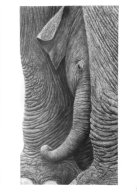
The textures found on Elephants skin have always fascinated me!
Did you know: Elephant skin lacks moisture so it must be loose, especially around the joints, to provide the necessary flexibility for motion.

Did you know: In Australia, these birds are known as "Bin Chickens" because they often hang around rubbish bins stealing food scraps. Due to its habit of rummaging in garbage, the species has, in typical Aussie fashion, become an icon of Australia's popular culture, regarded with glee by some and passionate revulsion by others.
